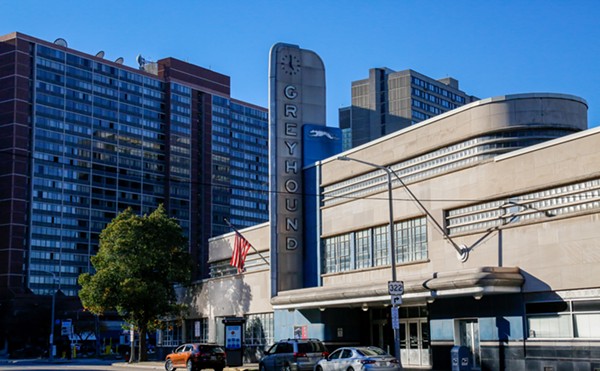Take, for instance, Fidardo Landi's "Mermaids"--a marble sculpture anchored on the east bank of Wade Lagoon. A conservator's 1992 assessment of the artwork reads like a medical report on a very sick patient. Noting one figure's missing nose, a heavy accumulation of bird guano, staining, erosion, cracks, splits, and holes, the assessment simply concludes: "Urgent need of treatment."
The vitals on the rest of the statues are the same, except for the common scars left on their bases by careless lawnmower operators.
In August, almost seven years after its bleak assessment, "Mermaids" is scheduled to receive its long-overdue makeover. (The noseless mermaid's proboscis, however, won't be rebuilt, just sealed.) The restoration is one of thirteen conservation projects the Sculpture Center hopes to complete this year as part of its Outdoor Sculpture Conservation Program.
An artists' gallery founded in 1989 by renowned sculptor David E. Davis, the Sculpture Center has restored outdoor sculptures in each of the past three years, and this year has turned its attention to artworks in and around University Circle's Fine Arts Garden. The area was conceived by Cleveland's wealthy families specifically for the placement of great artworks reflecting themes in nature. Other works scheduled to receive a makeover are "Night Passing the Earth to Day," "Fountain of the Waters," "Twelve Signs of the Zodiac," and "Spring Racing the Wind," all created in the late 1920s.
The Sculpture Center also plans to conserve several monuments honoring significant Clevelanders. The monuments are located adjacent to the Fine Arts Garden. (A pair of bronze lampposts constructed by Joseph Gosling in 1929 to commemorate the fiftieth anniversary of the invention of the incandescent lightbulb will also be restored. )
"Our committee had a hard time deciding which sculpture in the Fine Arts Garden to preserve, because they are all in such bad condition. So we decided to do them all," says Juilee Decker, the Sculpture Center's conservation coordinator.
Although many of the works--which date back as far as 1899--sit on the property adjacent to the art museum, the sculptures are owned by the City of Cleveland, which has not properly maintained them.
"Unfortunately, these sculptures have not received any conservation or maintenance and are suffering the effects of weather, pollution, vandalism, and neglect," says Decker, a part-time employee and Ph.D. candidate at Case Western Reserve University who is responsible for raising money for the ambitious restoration project.
The Sculpture Center, whose conservation program grew out of the Smithsonian Institution's national Save Outdoor Sculpture! campaign, will need $187,000 to restore all of the statues on its 1999 hit list. To date, Decker says, the center has received funding commitments totaling $130,000 from such sources as the Louise H. and David S. Ingalls Foundation, the Holden Parks Trust, the Kulas Foundation, and the Cleveland and Gund foundations. "I'm confident we will get the [rest of] the money," she says.
This year's effort is more ambitious than past programs, because of the number of sculptures targeted for restoration--31 separate pieces--and the addition of complicated marble statues, some of which are in a fragile state. Among the most significant works scheduled for conservation are the Harvey Rice monument, completed in 1899, and a bronze sculpture honoring Clevelander Marcus Hanna, created by famed artist Augustus Saint-Gaudens in 1907.
In addition to conserving the artworks, Decker says the Sculpture Center plans to install a plaque near the Fine Arts Garden noting the sculptures and their relationship to each other. "People go there all the time, and they have no clue," she says.
Much of the Sculpture Center's recent restoration work has taken place downtown. In 1998, the Sculpture Center restored the statue of Abraham Lincoln that sits outside the Cleveland Board of Education on East Sixth Street, the Commodore Oliver Hazard Perry monument in Fort Huntington Park on Lakeside Avenue and West Third Street, and the statue of the young George Washington located in front of the federal building at Lakeside Avenue and East Sixth Street.
Once the sculptures are restored, conservationists can't walk away, because the sculptures must be maintained to avoid further deterioration. But maintenance is a tall order, with approximately 180 sculptures in the city alone. Decker says this is why the Sculpture Center is trying to create partnerships with area institutions--such as museums and schools--to provide ongoing maintenance programs involving washing, waxing, and buffing of the art.
Decker says she is happy with the response from area institutions thus far. The Cleveland Museum of Art has committed to maintaining the sculptures in the Fine Arts Garden for the next 25 years.
"Once someone is properly trained, doing maintenance is not difficult," says Decker, who hopes to increase the maintenance awareness through the center's ongoing education programs and her own teaching at the Cleveland Institute of Art. "We have received interest from a number of high school teachers who want to help."
"[Maintenance] is a real issue," says Kathleen Coakley, executive director of Cleveland's Committee for Public Art. "It is a problem, because often the sponsors of the sculptures have died."
Although the City of Cleveland has not committed any money to the maintenance of sculptures, the city "has been great in giving me whatever I need," says Decker, who notes the city's willingness to streamline the permit process and to provide electrical and water hook-ups at each site. "They cut through all the red tape for us. Conservators say the access is amazing compared to other places."
Dave Abbott of University Circle Inc., which coordinates development in the art museum area, says it's too early to say if sculpture maintenance will become part of his organization's plans for the area.
"We certainly support [the Sculpture Center's] program, because the sculptures are distinguishing features of the Circle," says Abbott. "My guess is that the sculptures were not a high priority in the past. Only recently did [University Circle Inc.] become concerned about aesthetics of the Circle. Our mission is always evolving."
University Circle Inc. has a landscape committee--on which Sculpture Center founder David Davis sits--that will be studying how to improve the grounds and walkways around University Circle institutions.
Regardless of what University Circle Inc. decides to do to the grounds, the two mermaids embracing at the lagoon's edge will be ready for attention, broken nose and all.
Mark Naymik may be reached at [email protected].













